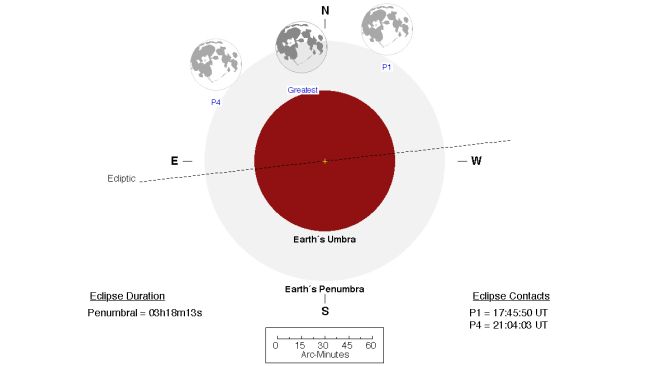Swoon over Full Strawberry Moon and other June sights in Arizona skies
May 27, 2020, 2:00 PM

A full moon rises behind St Michael's Mount in Marazion near Penzance on June 28, 2018 in Cornwall, England. (Photo by Matt Cardy/Getty Images)
(Photo by Matt Cardy/Getty Images)
The Earth has raced nearly halfway around its orbit since January as we reach the other side of our racetrack around the sun.
June is a most interesting month, as this is the official beginning of summer and the start of the monsoon season here in Arizona.
That means that there is still a good month of decent dark and clear skies before this weather phenomenon moves into our region.
The month of June offers up another fabulous full moon, as we move toward the Full Strawberry Moon on June 5. This full moon will be at its best at 12:12 p.m. MST during the daylight hours in Arizona, but expect a fantastic sight as the moon rises in the ESE sky at 7:48 p.m. MST.
At that time, the moon will be some 230,000 miles away from us and not be classified as Perigee-Syzygy moon — or a Super Moon.
The sun on that day will set at 7:35 p.m. MST, as it will take the moon some 13 minutes to rise, just after sunset.
Get those camera and smart phone devices out, as you will capture some wonderful sights to cherish for a long time to come.
Just to be accurate, there is a slight eclipse of the moon going on during the June full moon. It will not be visible for us in Arizona, as this will take place during daylight hours for us, but some observers around the world may notice a slight graying of the moon’s brilliance.
This will occur for observers in Asia and Africa and will appear like this:
Don’t feel left out, as we get to see another penumbral lunar eclipse on the evening of July 4.
This event will take place beginning at 8:07 p.m. MST and reach maximum at 9:30 p.m. MST. The northern or upper region of the moon will darken just a bit!
This is how the moon will appear next to the Earth’s shadow:
The next grand total lunar eclipse for us here in Arizona will occur on May 26, 2021, and will occur around 4 a.m. MST.
The moon will then move on to its last quarter phase on the June 13 and pass near Mars in the morning sky on June 12.
The best is yet to come, as the moon reaches its new phase on the 21st, as we begin the true summer season in Arizona. The summer solstice will occur on June 20 at 2:43 p.m. MST.
The dark skies of a new moon offer a grand opportunity to scan the skies and learn about the many treasures that lie in the Arizona skies.
The Milky Way is at its best at this time, low in the S around 2 a.m. MST, with the rich star clouds of Scorpius and Sagittarius.
The moon then waxes and reappears in the W sky around the 29th.
We begin in the evening sky, as we get a great view of elusive Mercury. This planet, closest to the Sun, will be easy to see by looking low in the WNW after sunset. Mercury will appear some 24 degrees high by June 4.
Venus will be saying goodbye as an evening planet and reaches inferior conjunction on June 3.
Venus will return to the morning sky later in June and July and at its brightest on July 10 before dawn.
The late night and early morning sky offer some superb sights, as both Jupiter and Saturn are close together in all of June, rising in the ESE around local midnight and high in the S at dawn.
Get those telescopes out for viewing these two amazing objects.
One last planet to view, as we come upon Mars.
Mars is rapidly getting brighter and will be setting up to come very close to Earth in October. Now is the time to begin your observations of Mars, as the planet rises in the SE around 1:30 a.m. MST in Aquarius.
Mars will be at its best on Oct. 13 as it moves within 37 million miles of Earth and will be a major object to view in the telescope.
Details of the great 2020 Mars Opposition can be found here.
Finally, many of you have been looking for information on how best to view Comet SWAN C/2020 F8.
The comet may be visible in binoculars, low in the WNW sky, during the first week of June.
Here is the best information on how you may get to see it.
Clear skies!
To print your own monthly star chart, click here.
To view satellites/dates/times of passage, click here.
Listen to the Dr. Sky Show on KTAR News 92.3 FM every Saturday at 3 a.m.











